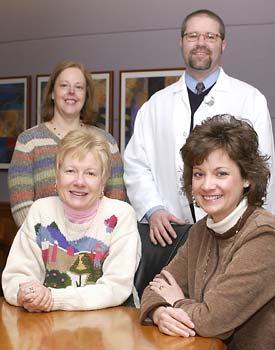A dedicated team of U-M staff members is working to save the lives of children with neuroblastoma, one of the most common solid tumors of early childhood.

“These individuals have dedicated an enormous amount of time and effort without any compensation,” says Dr. Gregory Yanik, clinical professor associate in Pediatrics Hematology-Oncology. The team was assembled with no funding”just a group of individuals committed to helping children with neuroblastoma,” Yanik says.
Team members include David Hubers, Shelli Anuszkiewicz, Denise Regan and Cynthia Bower. These individuals are among several people who are working hard to combat neuroblastoma with I-131 meta-iodobenzylguanidine (MIBG) treatment.
“The I-131 MIBG therapy solution was discovered by Don Weiland of the U-M Division of Nuclear Medicine in the 1970s,” Hubers, a nuclear pharmacist and director of the U-M Nuclear Pharmacy, says. “The division of nuclear medicine pioneered usage of this radiolabel for both diagnosing and treating neuroblastoma.” Hubers’ position entails the provision of clinical radiopharmaceuticals, assisting in the development and synthesis of research tracers, and serving on the U-M Radioactive Drug Research and Radiation Policy committees.
Hubers trained at Purdue University, one of only a half dozen pharmacy schools in the nation that provides nuclear pharmacy training. “I find it remarkable that radioactivity, a concept that most people find frightening and associate with a nuclear threat can be used to diagnose and treat patients,” Hubers says. As the only nuclear pharmacist on staff at the University Hospital, it is Hubers’ responsibility to ensure the I-131 MIBG therapy solution is pharmaceutically suitable for infusion into patients, perform the actual dispensing of the therapy doses, and assist the medical staff with any radiation safety or pharmacology related questions.
In his free time, Hubers enjoys reading of all sorts, including medical journals, espionage novels, and World War II and Vietnam history. He also participates in summer softball leagues and enjoys spending time with his wife and two young children, Dane and Dre.
Anuszkiewicz, a registered nurse and clinical care coordinator for the Pediatric Blood and Marrow Transplant Program, has been involved with caring for neuroblastoma patients since her arrival at U-M in 1990. Originally from Jackson, Mich., Anuszkiewicz knew during her nursing rotation at Grand Valley State University that she wanted to work with children because of the way that kids take everything in stride. “They are so resilient,” Anuszkiewicz says.
Anuszkiewicz’s role in the neuroblastoma team is that of “front-door person” to families pursuing MIBG therapy at U-M. “I have several lengthy telephone conversations with parents as they gather information about the therapy,” Anuszkiewicz says. “I meet with them along with the physician during their consultation here and continue to track the progress of the patient as we move closer to the actual admission day for therapy.”
In addition, Anuszkiewicz is responsible for coordinating all the involved U-M disciplines.
Anuszkiewicz likes to spend her free time with her husband and three children. An outdoor enthusiast, she enjoys reading, photography and gardening. “I find these activities relaxing and therapeutic,” Anuszkiewicz says.
Regan, a nuclear medicine technologist II, had already been doing other radionuclide therapies as a research technologist for about 8 years when she was asked to join the MIBG team. A graduate of U-M, Regan was working in a lab when she decided she would rather work with patients, and went on to obtain certification in nuclear medicine. She administers the radioactive MIBG, and follows up by taking radiation readings of the patients daily, so that they can be discharged at a safe radiation level. She also is responsible for making sure families, doctors and nurses follow the proper radiation precautions while treating a patient with radioactive substances.
Regan, who received her nuclear medicine certification through Beaumont Hospital, enjoys spending her free time with her husband and three children. She also likes to travel, camp, garden and cook.
Bower, a clinical nurse specialist with the General Clinical Research Center on 7A in the University Hospital, is in charge of many aspects of the neuroblastoma program. Bower administers patient care, advocates and protects patients, their families and staff, and also is the educational support to the staff in the direct care of the pediatric patient and protection of the human subject. “I function as the liaison with nuclear medicine to adhere to the regulatory requirements and precautions associated with target specific radiation administration,” Bower says. “I work with the transplant coordinator and the transplant team to coordinate the admission of these patients to our unit.”
When not working, Bower enjoys spending time with her two children, whether it is watching her son play hockey or her daughter ride horses. She also enjoys nature photography and gardening, as well as cooking.

